The 2013 MacBook Air Review (11-inch)
by Vivek Gowri on August 9, 2013 1:45 AM ESTThe performance story is a bit interesting. There are two sets of 15W Haswell ULT parts, some with HD 4400 (GT2) and others with HD 5000 (GT3) onboard graphics. The GT3 parts, in order to hit the same TDP, run lower clock speeds. Apple chose to go for GT3 across the board. This isn’t the first time that Apple has made the decision to sacrifice CPU performance for the sake of GPU, but this was probably a pretty easy choice for them compared to 2010, when they skipped Arrandale on the 13” MacBook Pro and Airs for Penryn-era Core 2 Duo and Nvidia’s G 320M. That particular IGP was pretty fast, so much so that the substantially improved HD 3000 that came with the Sandy Bridge mobile parts was actually a bit of a downgrade on them.
The CPU tradeoff here is substantially less than it has been in the past, so this is a bit of a no-brainer. The i5-4250U in the base 2013 MacBook Air is clocked at a low 1.3GHz but has the same 2.6/2.3GHz (single core/dual core) turbo clocks as the 1.6GHz i5-4200U with GT2 graphics. The clock speed difference is even less at the high end: the optional i7-4650U is clocked at 1.7GHz and turbos to 3.3/2.9GHz while the fastest GT2 ULT part, the i7-4500U, runs 1.8/3.0/2.7GHz. The hit you take on base clock is pretty easy to justify for the more powerful GPU.
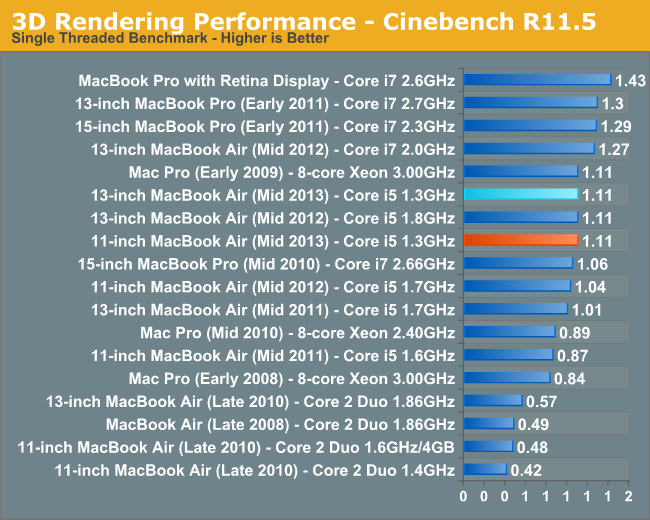
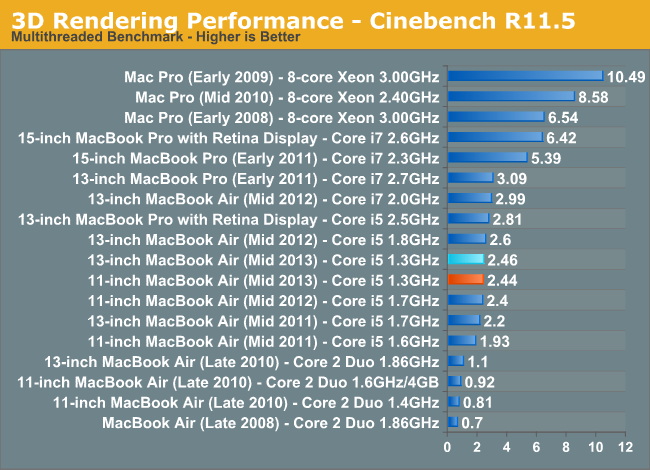 With that said, the raw performance isn’t really that great. The 13” Air that Anand reviewed was slower than its immediate predecessor, which used a 1.8GHz i5-3427U. The base 11” last year used an i5-3317U (1.7GHz) and that’s actually not a whole lot faster than the 11” Air I have here. The results are basically all within margin of error for the tests, so I’m content to call it basically even with last year’s model. The Air isn’t slow, but it can certainly get pokey at times. This is no different than any Ultrabook-class machine, but worth noting. Turbo and the very fast SSD keep things going smoothly in normal day-to-day tasks, but anything substantially more intensive than a browser and iTunes is going to be outside the comfort zone of a system like this.
With that said, the raw performance isn’t really that great. The 13” Air that Anand reviewed was slower than its immediate predecessor, which used a 1.8GHz i5-3427U. The base 11” last year used an i5-3317U (1.7GHz) and that’s actually not a whole lot faster than the 11” Air I have here. The results are basically all within margin of error for the tests, so I’m content to call it basically even with last year’s model. The Air isn’t slow, but it can certainly get pokey at times. This is no different than any Ultrabook-class machine, but worth noting. Turbo and the very fast SSD keep things going smoothly in normal day-to-day tasks, but anything substantially more intensive than a browser and iTunes is going to be outside the comfort zone of a system like this.
Considering the power efficiency though, getting similar performance to the old model even with 30% slower base clocks is a decent bargain, particularly when accounting for the increase in GPU and storage performance. I’m not going to go too far into those, since Anand did a really deep dive in his 13” Air review. It’s worth noting that while his Air had a Samsung SSD, the supplier lottery churned out a SanDisk SSD in my unit. The switch to PCIe SSDs really does make itself felt in day to day use, particularly in sleep/wake situations, as well as when launching particularly large applications (that then crawl their way through the power-sipping i5 ULT). I honestly didn’t expect that, given how accustomed I’ve become to the responsiveness of fast SSDs in general, but it’s pretty important to the MacBook Air simply in terms of keeping the system feeling quick to the touch.
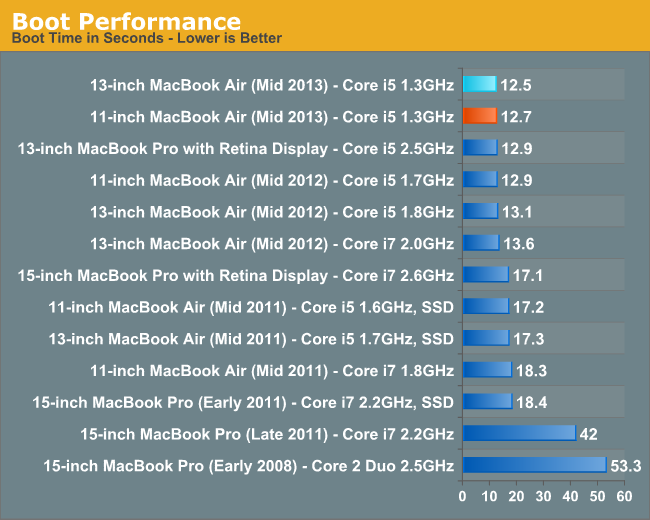

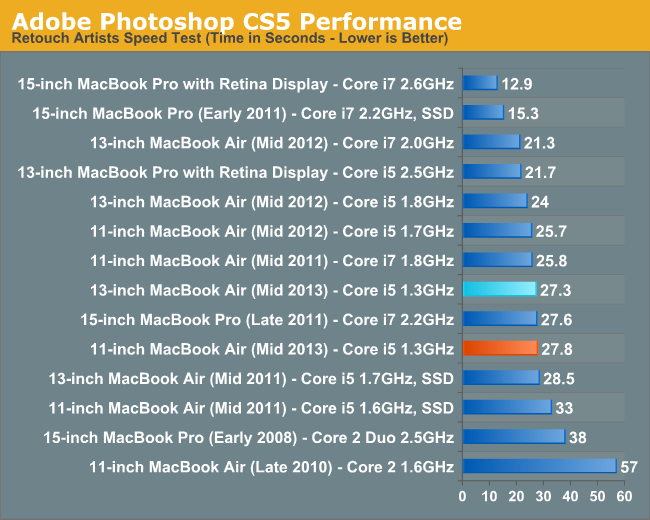


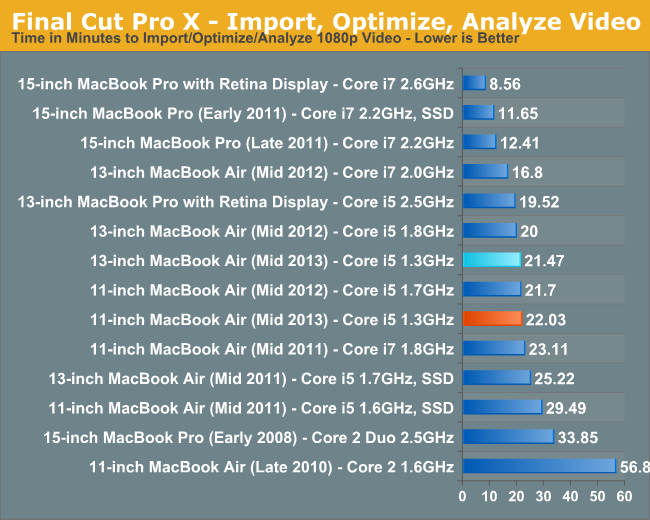










139 Comments
View All Comments
solipsism - Saturday, August 10, 2013 - link
Your first paragraph compares a RAIDed system to a single drive system that then says it's "just as fast" then your 2nd paragraph argues that the MBA can't benefit from having a PCIe SSD over a SATA SSD.Do you honestly don't know what faster storage can do for disk reads and writes? Do you think Anand lied about the results of his 2013 13" MBA comparison?
128K Sequntial Writes:
2010 MBP — 89 MB/s
2013 MBA — 714.2 MB/s
How exactly does that not offer any benefit?
ESC2000 - Saturday, August 10, 2013 - link
Anyone who reads this review and thinks there is anti apple bias is himself biased toward Apple. You've made your position pretty clear.Anandtech has done three major articles/reviews of Mac laptops in the past two months and basically none on any other laptops. That should be pro Apple enough for you.
ESC2000 - Saturday, August 10, 2013 - link
Just to be clear, that is a response to darwinosx not Vivek.IHateMyJob2004 - Friday, August 9, 2013 - link
$999? Who would spend that much on a small screen laptop? Only fools ....solipsism - Friday, August 9, 2013 - link
Because the performance, quality and utility of a device is based solely on the size of the display? I guess that means it's foolish to even spend $200 on a cheap cellphone since the display on those is much smaller¡purerice - Friday, August 9, 2013 - link
Good point. Actually in the end you end up paying over $600 for that $200 cell which just adds to your point. This can handle 1600p resolution on an external display. Not for Crysis but it will run Excel fine.I used to have a 12" laptop with 1024x768 screen that I attached to a Dell 2407 when at my home office. At the time 4.6 lb (2.1kg) was light for a laptop. Having a small laptop for the road that you can plug in to a beautiful display at home is the best of both worlds. I would rather have a fully functional, 2.4 lb 11" laptop with SSD for $1000 than 15" laptop that weighs 3x and has a 5400 rpm hard drive for $600.
I replaced that 12" laptop with a 6 lb, 15" Penryn-based Dell laptop that got 90 minutes of battery life new, that was about $600. I use it when I have to for work and looking back I gladly would trade portability, HD speed, and battery life for the higher screen resolution, a little speed, and $400. Most gladly.
Though now that Toshiba's IB-based U925 is no longer available, I am hoping they replace it with a Haswell version. Touchscreen+tablet mode are features I would rarely use, but in certain cases they would be extremely helpful.
jutre - Friday, August 9, 2013 - link
And what about the RAM ? Is 4GB (not up-gradable) acceptable for anybody ? If you buy your laptop today, it is for using it for the next couple years. I guess forking 100$ for the extra RAM in order to futureproof your laptop a no brainer ?purerice - Friday, August 9, 2013 - link
I think so. LPDDR3 memory that Apple uses here and Sony uses with the Vaio Duo is (almost?) always attached to the motherboard, unlike most DDR3L memory. There will likely be other bottlenecks for sure, but especially with shared vram, the 4GB is closer to 3-3.5GB.name99 - Saturday, August 10, 2013 - link
Are you people retarded?This is not a machine being sold to run huge Mathematica simulations, or to host 4 simultaneous VMs. It's a machine sold to people who perform "normal" computing tasks, basically email, web, reading PDFs, maybe MS Office, maybe some arranging photos, maybe some light gaming.
You're like people who look at the specs for a 2-door sedan and complain "But what if I want to use it to tow my boat 24 hours a day?"
If it doesn't fit your computing needs, don't fscking buy it. It doesn't meet my needs (which DO include substantial Mathematic usage), so I bought a quad-core 16GB 15" rMBP. The difference is I don't waste everyone's time by claiming that the entire damn world has the same computing needs that I do.
Does it meet my GF's needs? My mother's needs? My two sister's needs? Yes, yes and yes.
My programmer brother's needs? No.
That's why Apple makes multiple laptops!!!
TheinsanegamerN - Sunday, August 11, 2013 - link
dude, roid rage much?nobody is retarded here. they were having a legitimate conversation on the ram found in the macbook air, and then you butted in.
normal users can run over 4 GB of ram usage. ask anyone who runs multiple tabs while a video is playing in the background.
and nobody was claiming that the world has the same computational needs as them.
so kindly shut up and go back to your "Mathematical equations" and leave socializing to people who are not incredibly rude morons.